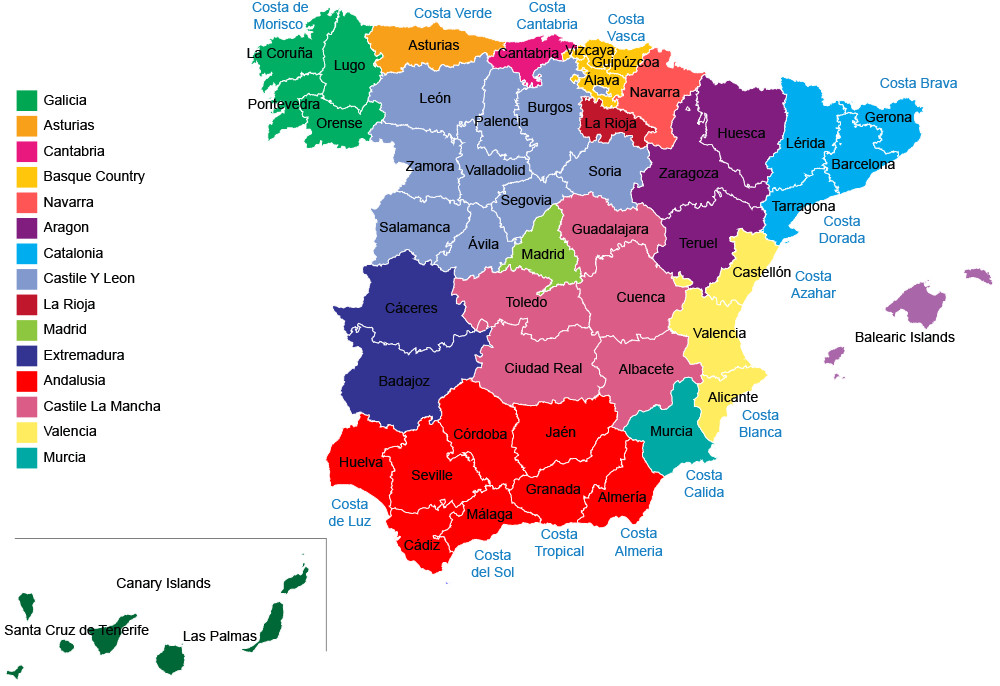Understanding the Administrative Structure of Spain: Autonomous Communities, Provinces, Municipalities, Cities, Neighborhoods, and Urbanizations
Introduction
Spain is a country with a rich history and diverse cultures, and this diversity is reflected in its administrative and territorial organization. To manage this variety effectively, Spain has a multi-layered administrative structure that allows for local governance and autonomy. This structure includes several levels, each with specific roles and responsibilities: Autonomous Communities, Provinces, Municipalities, Cities, Neighborhoods, and Urbanizations. Understanding how these levels fit together helps us appreciate how Spain functions as a cohesive yet decentralized state. Below is a detailed breakdown of each level, illustrating how they interact within the broader administrative framework.
1. Autonomous Community (Comunidad Autónoma)
At the highest level of regional governance, Spain is divided into 17 Autonomous Communities and 2 autonomous cities (Ceuta and Melilla). These communities were established to recognize the country’s diverse cultural, linguistic, and historical differences. Each Autonomous Community has its own government, parliament, and administrative powers. They enjoy a significant degree of autonomy, with competencies in areas such as education, health, and infrastructure. The Spanish Constitution of 1978 laid the foundation for this system, aiming to provide self-governance while maintaining national unity.
2. Province (Provincia)
Autonomous Communities are further divided into Provinces. Spain has 50 provinces in total, serving as an intermediary level of administration between the Autonomous Communities and Municipalities. Provinces play a crucial role in organizing regional elections, coordinating services that span multiple municipalities, and managing certain administrative tasks. Each province has a capital, which is usually the largest city in the province, and a governing body known as the “Diputación Provincial” that oversees regional services.
3. Municipality (Municipio)
Provinces are subdivided into Municipalities, which are the most basic local administrative units in Spain. There are over 8,000 municipalities across the country, ranging in size from small villages to large urban centers. Municipalities have their own elected councils, known as “Ayuntamiento,” responsible for local governance, including urban planning, local roads, public services, and community welfare. Mayors (“Alcaldes”) are elected to lead these councils and represent the municipality.
4. City (Ciudad)
Cities are essentially larger municipalities with more significant populations and infrastructure. In Spain, not all municipalities are cities, but all cities are municipalities. Cities often have a more complex administrative structure due to their size and the needs of their population. In addition to the local council, larger cities might have various districts or boroughs, each with its own sub-councils to handle local matters more effectively.
5. Neighborhood (Barrio)
Within cities and larger municipalities, Neighborhoods represent smaller administrative or social units. Neighborhoods can be distinct due to historical, cultural, or geographical reasons and often have their own local identity. In some cities, neighborhoods have neighborhood associations or councils that participate in the city’s decision-making processes, representing the interests and needs of local residents.
6. Urbanization (Urbanización)
Urbanizations refer to residential developments or housing complexes often found on the outskirts of cities or in rural areas. These are typically planned communities with a collection of homes, facilities, and sometimes commercial areas. Urbanizations may not have the formal administrative structures that neighborhoods or municipalities have, but they often have homeowners’ associations that manage common areas and community services.
This structured hierarchy enables Spain to accommodate regional differences while maintaining national coherence, making it a unique example of a decentralized nation. Each level of this administrative structure has specific functions and responsibilities, ensuring that the needs of communities, from the largest autonomous regions to the smallest neighborhoods, are effectively managed.



